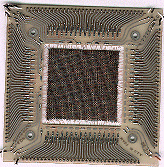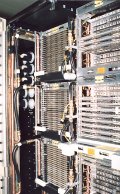
CDC 6000 series and CYBER 70-series core memory.
One of the 12 layers of a memory block showing 64*64 bits.
Enlarge to real size or look at macro photo of some bits.
![[TNO-logo]](banner.gif)
 The 6400 was a less-powerful successor to the famous 6600,
which was introduced in 1964. The 6600
is sometimes referred to
as the first RISC machine, due to its limited instruction set and generally uncomplicated design.
Under the covers, the CPU was a traditional unified processor,
as opposed to the more sophisticated 6600 with its multiple functional units.
Like today's RISC machines, the 6600 could
execute multiple instructions simultaneously. But the 6400 lacked
this capability, making it a 2.5 times slower machine than the single-CPU
6600.
The 6400 was a less-powerful successor to the famous 6600,
which was introduced in 1964. The 6600
is sometimes referred to
as the first RISC machine, due to its limited instruction set and generally uncomplicated design.
Under the covers, the CPU was a traditional unified processor,
as opposed to the more sophisticated 6600 with its multiple functional units.
Like today's RISC machines, the 6600 could
execute multiple instructions simultaneously. But the 6400 lacked
this capability, making it a 2.5 times slower machine than the single-CPU
6600.
By the mid-70's Control Data, a member of the original BUNCH competitors to IBM (Burroughs, Univac, NCR, Control Data, and Honeywell) had a less-than-robust share of the computer market. It may be surprising, then, that it supported several operating systems on its 6000 series. These included:
Back then, our idea of an "application" was a compiler or OS utility; there weren't too many commercially available traditional applications for CDC systems. However, there were SPSS (a statistical package) and IMSL (FORTRAN math subroutine library).
Control Data came out with four lines of computers compatible with the original 6600: the 6000 Series, the Cyber 70 Series, the Cyber 170 Series, and the Cyber 180 Series series. (the 7600 and its successors are included in with these four lines, even though the 7600 had slightly different I/O.) There wasn't a whole lot of difference amoungst the 6000 (discrete technology; core memory), 70, and 170 lines with exception of type of packaging, memory and cooling technology. On the other hand, for the most part, the Cyber 180 Series really was a new line. Most of the Cyber 180's were dramatically different CISC machines that had a 6000 compatibility mode. (There were a few models in the 180 Series that were just of the same old architecture with a new name again.)
The Control Data 6400 had roughly the power of an Intel 386+387 and a number of MIPS which could probably be bought today on the used market for about US$ 400.

CDC 6000 series and CYBER 70-series core memory.
One of the 12 layers of a memory block showing 64*64 bits.
Enlarge to real size or
look at macro photo of some bits.
(with special thanks to Mark Riordan who provided the basis for this page)
 [email protected]
[email protected]